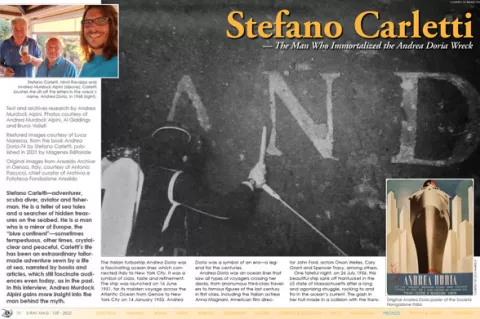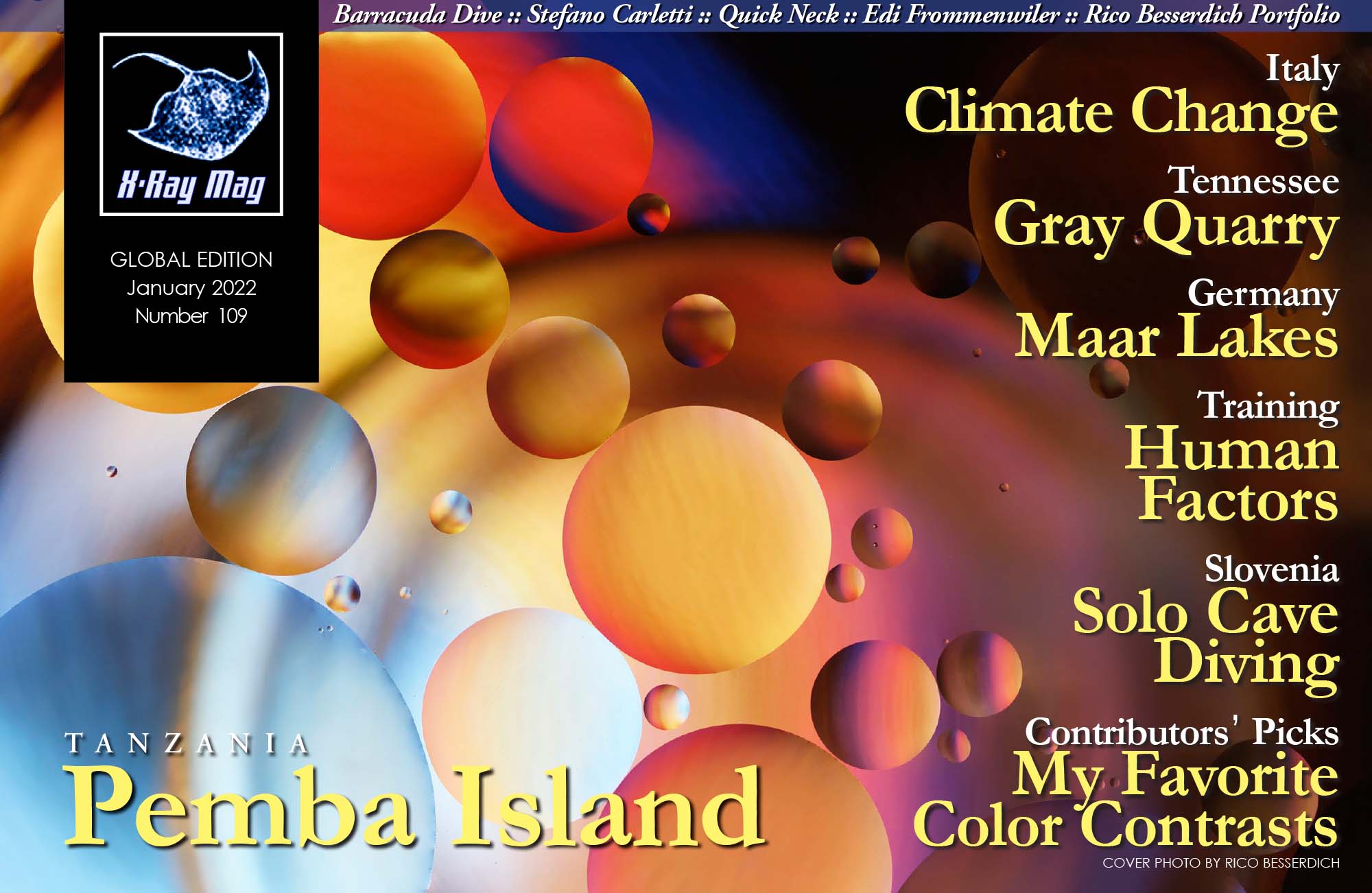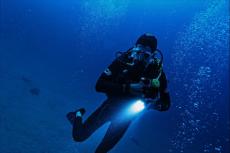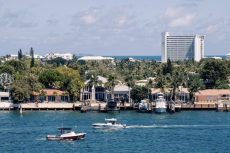Stefano Carletti—adventurer, scuba diver, aviator and fisherman. He is a teller of sea tales and a searcher of hidden treasures on the seabed. He is a man who is a mirror of Europe, the “blue continent”—sometimes tempestuous, other times, crystal-clear and peaceful. Carletti’s life has been an extraordinary tailor-made adventure sewn by a life at sea, narrated by books and articles, which still fascinate audiences even today, as in the past. In this interview, Andrea Murdock Alpini gains more insight into the man behind the myth.
Contributed by
Factfile
Text and archives research by Andrea Murdock Alpini
Restored images courtesy of Luca Maresca, from the book Andrea Doria -74 by Stefano Carletti, published in 2021 by Magenes Editoriale
Original images from Ansaldo Archive in Genoa, Italy, courtesy of Antonio Pacucci, chief curator of Archivio e Fototeca Fondazione Ansaldo
The Italian turboship Andrea Doria was a fascinating ocean liner, which connected Italy to New York City. It was a symbol of class, taste and refinement. The ship was launched on 16 June 1951, for its maiden voyage across the Atlantic Ocean from Genoa to New York City on 14 January 1953. Andrea Doria was a symbol of an era—a legend for the centuries.

Andrea Doria was an ocean liner that saw all types of voyagers crossing her decks, from anonymous third-class travelers to famous figures of the last century in first class, including the Italian actress Anna Magnani, American film director John Ford, actors Orson Welles, Cary Grant and Spencer Tracy, among others.
One fateful night, on 26 July 1956, this beautiful ship sank off Nantucket in the US state of Massachusetts after a long and agonizing struggle, rocking to and fro in the ocean’s current. The gash in her hull made in a collision with the transatlantic liner Stockholm tore apart the right side of the Andrea Doria. Commander Piero Calamai was the last man to get off this ill-fated ship; the accident struck his soul so deeply that, for the rest of his life, he was obsessed by the event.
As the Atlantic Ocean engulfed the vessel, with the waters churning and foaming about it, TV channels worldwide broadcast the sinking of the most beautiful ship ever built in the modern era. The dreams of a nation came to an end on the muddy seabed, as the ocean welcomed the Andrea Doria, transformed into myth by her demise.
Over a decade later, in the summer of 1968, Italian filmmaker and scuba diver Bruno Vailati gathered a crew of adventurers to go to the United States to film the wreck of the Andrea Doria for the first time ever. The crew included Mimì Dies, Arnaldo Mattei, Al Giddings and, last but not least, Stefano Carletti—the man who made the wreck of the Andrea Doria immortal.

Upon his return to Rome after the expedition, Carletti wrote the first-ever book about the wreck, entitled Andrea Doria -74. The book was a collection of feelings and rare images captured during scuba dives conducted from the expedition’s side ship, Narragansett, where Carletti and the crew spent a month.
The first edition of the book has now become treasured memorabilia for collectors worldwide. Now, a new updated edition, with restored images and a new introduction by the author as well as a critical essay that I contributed, has been published in 2021 by Magenes Editoriale. It is a chance for wreck junkies and historians to acquire a stunning re-edition of this legendary book for their private libraries.
Scuba diving tales in the following interview provide a background, an excuse to bring to the surface some fantastic underwater events and anecdotes, which would otherwise be hidden (forever), in time.

AMA: Who is Stefano Carletti, today?
SC: Stefano Carletti today is an 80-year-old man, a kind of living anecdote.
AMA: Do you remember the dinner we had one winter evening with Paolo Barone in Rome? He granted us a small ink bottle, which he had salvaged from the wreck of the Laura C., which sank off Calabria’s shore. Our conversation started there with an ink pen and some stories to be recalled and told.
SC: Of course, I remember that great dinner we had together in Rome. One of first ice-breaking questions was about the practice of writing, a world that we both love. Writing is an activity that has been with me throughout my life—one which I have never given up, by the way, to go to the sea.
At present, I own a small fishing boat that makes me happy during summertime, from early June to September. Usually, I sail the central and southern Mediterranean Sea. Sicily, Sardinia, Tunisia and Libya are my favorite spots where I have gone fishing over the decades.
Fishing is an expression of freedom for me. This activity allows me to return to a special spot I have been visiting for 40 years. Year by year, I go back with a bitter smile, though. Everything has changed, for the worse.
I am still a scuba diver too. I have not abandoned diving. I don’t pass up opportunities to dive with good friends. I look at the sea with different eyes though, from the ones I had as a boy.
AMA: Do you see yourself as a scuba diver or a fisher with scuba gear?
SC: The world has changed. Once, a long time ago, the main goal of diving was to hunt fish. Everything was held to the limits that freediving had imposed in those times. Scuba gear changed the scenario: We could go deeper and stay underwater longer. We had, for the first time, the chance to catch huge-sized fish. We felt we were hunters more than scuba divers.
I never polluted the sea, but 56 years later, I am aware that I have taken advantage of it. Mine are not the confessions of an old man. I was aware of it at the time but can admit just trying to survive in life had pushed me to it. I have written a book some decades ago entitled Naumachos. In it, there is a chapter that talks about a sort of regret. But it was a different time then, with different rules.
Sponges, red coral, fishes, ancient Roman urns and wrecks… that was what I have hunted in my life to earn my daily bread. We did stuff back then that was nearly illegal. Probably, if you tried to do the same today, you would go to jail. Back then, the sea belonged to all who were crazy and brave enough to explore it.
Wrecks? Those were considered res nullius (nobody’s thing), as the ancient Romans used to say. Wrecks never belonged to anybody. There were no rules on this matter back then.

AMA: How was the idea to film the wreck of the Andrea Doria born?
SC: That is a very funny story. The whole idea was born while Bruno Vailati was on board the minesweeper Giaggiolo, a ship that belonged to the Italian Navy. In 1967, Bruno was sailing on board this navy ship, heading to Lampedusa Island (a remote and small Italian island close to Tunisia’s coast). At the time, I was making a living on the island as a shark hunter, and you know, Doria was famous for sharks. Bruno was preparing a series of marine life documentaries entitled I Setti Mari (The Seven Seas), and was interested in filming some WWII wrecks that I had discovered on the seabed, whose stories were completely unknown.
One evening, Bruno invited me on board Giaggiolo to bug me. He reminded me that the group of French explorers led by Jacques-Yves Cousteau failed in their attempt to document Doria off the Nantucket shoal. I decided to play a joke on him, and what I said was partially true… I told Bruno I was linked with a member of Cousteau’s crew.

So then Bruno told me all the details of the French expedition to the Doria, shoot by shoot, and he also mentioned the remote research vehicle that they had lost during their work on the wreck. I was very intrigued by his report. Finally, I said: “Bruno, look, if the Andrea Doria were here, I could break it down bolt by bolt… have you seen how many wrecks I have dived?”
Some months later, in wintertime, I saw Bruno again to work together on the footage we filmed during the summer. Once again, Bruno caught me by surprise: “Stefano! Prepare yourself for a press conference. We are announcing that we will arrange an expedition to the wreck of the Doria!”
I didn’t know anything about this beautiful ocean liner except the chronicles of its sinking. I didn’t have an exact idea of where it was. The Expedition Board asked us to conduct accurate historical research and write a report after each dive we made on the wreck.
As I began working on this matter, I found an air of mystery about the sinking and the wreck. The LORAN coordinates taken by Doria’s commander, Piero Calamai, were kept confidential by the US Coast Guard and US Navy. Most of the information I found was inaccurate; journals had conflicting reports and a lot of details were wrong.
The whole story needed to be told. Our expedition has been written into history as a large-scale expedition, but honestly, we only sailed there for a great adventure.
AMA: What did the Doria represent to you at first glance—a ship or a wreck?
SC: The Andrea Doria expedition was born from a sort of afterthought. I was just following the intentions of the filmmaker, Bruno Vailati, to film an Italian wreck, which sank in difficult conditions. Not only the sea’s surface conditions, but also conditions underwater, was something that evoked our interest in the wreck.
Our goal was to capture good quality images of the ocean liner from the seabed to create an episode for the [documentary] series, I Sette Mari, an Italian television production. We were not yet fascinated by the Doria. We went to the United States to do a job. Emotions, at the time, played a small role in our trip; we were not engaged with the ship or the wreck.

AMA: “Death wreck,” a “fatal scuba dive,” the “Mount Everest of scuba diving”… These are some of Doria’s nicknames. Do you agree with these points of view?
SC: My dives on the wreck had been done with a Technisub wetsuit and a 12-liter twinset filled with air. Our scuba lights [back then] felt like candles compared with modern lights [of today]. I used to bring a hemp rope with me to the bottom for use as a main line in finding the way back to ascend [to the surface].
Today, on YouTube, one can see short videos or images of divers who have recently dived the wreck of the Doria in the wrong way. Most of them bring to the bottom of the sea a large quantity of useful stuff. However, the equipment itself makes the Doria dive dangerous, not the wreck. I am sure that poor technical diving skills and weak physical preparation put the divers in a place of no return… “a cul-de-sac.”
Finally, I can say that the media and scuba reports communicate in the wrong way how to approach the wreck; they have transformed a moderately difficult dive into a “fatal dive.”
The Andrea Doria wreck does not deserve to be placed into the black chronicles of scuba diving. I think it is imperative to rethink the current way to approach and dive this amazing wreck—probably more lives could be saved in the future.
A dive becomes “fatal” if the diver makes it so. The wreck has no responsibility at all.
AMA: Andrea Doria—from Dolce Vita ocean liner to legendary wreck. People say that, nowadays, there are more pieces of her stored inside American homes than on the seabed off the Nantucket shoal. Year by year, the Doria is cannibalized by divers from around the world. Did you collect any memorabilia during your exploration?

SC: Oh, no! I had never removed any relevant memorabilia from the Doria wreck. Most of our dives were done in the exterior parts of the ship. Only a few times did we go inside the wreck. I went to the command deck; I remember the helm and the stunning windows. Actually, I have only memories from the job I did on the Doria, nothing more.
AMA: In the early words of this interview, you said that the “sea is a kind of amniotic liquid.” What meaning do you give to sea?
SC: Indeed, the sea has a moral and aesthetic sense for me. The sea has become a primary biological requirement over the years, a mental state of mind. Due to this, it is simple for me to tell sea-based stories in my novels. I feel like the sea loves me.
In 1973, I was sailing on board a regatta in the Lion Gulf (France). During the storm, we sank. I was the only sailor to survive; the other six members of the crew died. I was rescued by a French cargo ship.
AMA: A while ago, you told me about an amazing adventure you had on board your private ultralight airplane—landing in Somalia on the Eastern Horn of Africa….
SC: We landed close to Cape Guardafui. A few months earlier, I had been sailing the Mediterranean on my fishing boat, when I came alongside a group of French adventurers who told me about some amazing places filled with treasures. When I got back to Rome, I decided to search some old aviation charts to find some airstrips. I pinned on the chart some locations for my P-68 fuel refills, and I started loading up cargo.
The city of Cairo in Egypt was the first stop. When we disembarked the aircraft in Somalia, we headed off in a Zodiac Mark II with a marine Evinrude 20CV motor, a Bauer air compressor and three pairs of twinsets. We had a great adventure! Unforgettable.
AMA: Ok, let’s come back to our starting point, the Doria. At the end of the first dive to the wreck, the filmmaker and expedition leader Bruno Vailati said, “We turned back and we looked at her.” For the first time, he appears melancholic. At the end of the expedition, the great filmmaker seemed to set aside the practice of placing the job before the ship, and he let feelings come up to the surface.
SC: The last dive we did was done in incredibly flat and calm sea conditions with no current. The visibility, for the first time, was stunning. I can probably say it was the only dive I had on Doria with crystal-clear visibility. It seemed that the wreck was showing itself to us.

During the previous 21 dives, we never really saw the Andrea Doria—we had only an idea of her. In some ways, the strong current and the cold water with tons of plankton hid the wreck from our gaze. I can say that our dives were more tactile than visual. What was in front of our eyes could have been a common ship. I only knew its name when I brushed silt, letter by letter, from its beautiful name on the hull. I will never forget when the name “Andrea Doria” appeared to me. It’s true, when we did the last dive, we said “Arriverderci” to the ship.
AMA: What is a wreck to you?
SC: A wreck, first of all, is a terrible loss—economical, psychological and human. A wreck is a part of humanity that ends up on the seabed.
Afterthoughts
Andrea Doria was launched in Genoa in 1951. Two decades later in 1971, a son of the same city, Fabrizio De André, composed a vinyl record inspired by The Spoon River Anthology by the American poet Edgar Lee Masters. The disc’s title track, “Non al denaro non all’amore nè al cielo” ("Not to money, nor to love or to heaven"), describes well the pure spirit of Carletti. He has loved, dived, flown, discovered, written, explored wrecks and bequeathed his stories throughout his lifetime.
The Italian expedition to the Andrea Doria was “provocative” and demanding. More than 50 years later, the film by Vailati has found a cult following and the famous book from Carletti, Andrea Doria -74, is now a collector’s item for wreck enthusiasts. Yes, by the way, we are lucky enough to have a restored edition published in 2021.
Thinking on it, the Andrea Doria has hundreds of meanings for Italian scuba divers. History for us is a base layer upon which we set up our projects. The daughter of Commander Piero Calamai reported that her father, a few minutes before passing away, asked: “Did I rescue all the passengers?”
The Andrea Doria wreck belongs to everybody. Divers might steal memorabilia from its skeleton or respect the memory of its glorious past. In the end, it does not matter how one approaches the dives on this amazing ocean liner. Ultimately, the Andrea Doria wreck will disappear from the Atlantic seabed, but her story will become immortal. Immortality is a destiny reserved only for the great wonders of the world. ■
Based in Italy, author Andrea Murdock Alpini is a technical diving instructor for TDI, CMAS and PSAI. Diving since 1997, he is a professional diver focused on advanced trimix deep diving, log dives with open circuit, decompression studies, and research on wrecks, mines and caves. Diving uncommon spots and arranging dive expeditions, he shoots footage of wrecks and writes presentations for conferences and articles for dive publications and websites such as ScubaPortal, Relitti in Liguria, Nautica Report, ScubaZone, Ocean4Future, InDepth and X-Ray Mag. He is also a member of the Historical Diving Society Italy (HDSI), and holds a master’s degree in architecture and an MBA in economics of arts. He is the founder of PHY Diving Equipment (phidiving.com), which specializes in undergarments for diving, as well as drysuits, hoods and tools for cave and wreck diving. Among other wrecks, he has dived the Scapa Flow wrecks heritage, Malin Head’s wrecks and the HMHS Britannic (-118m), Fw58C (-110m), SS Nina (-115m), Motonave Viminale (-108m), SS Marsala (-105m), UJ-2208 (-108m) and the submarine U-455 (-119m)—always on an open circuit system. His first book (in Italian), Deep Blue, about scuba diving exploration, was released in January 2020 (see amazon.it). For more information on courses, expeditions and dived wrecks, please visit: wreckdiving.it.







































